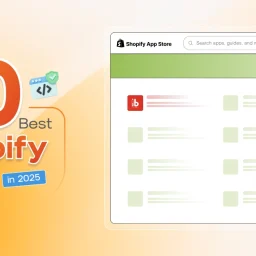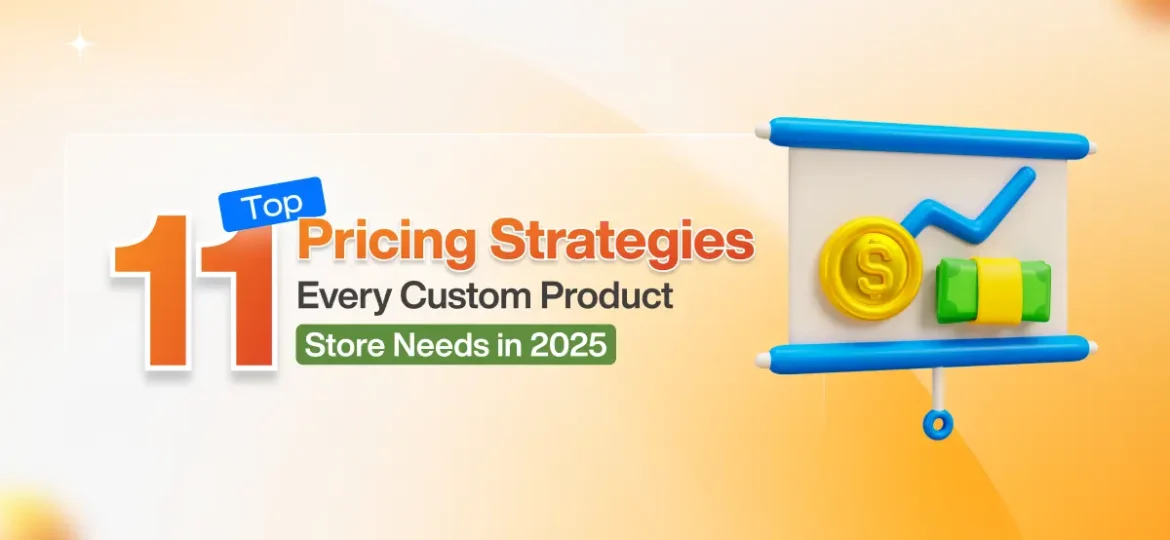
Last Updated on October 30, 2025
Product pricing strategies; it’s not just putting a number on your products, but defining how your brand competes, attracts customers, and sustains profit in a crowded market.
When you plan to build a custom store, most entrepreneurs focus more on developing creative ideas and turning them into a product people want to buy. But before you can start selling, the tricky part is to decide what your product is worth.
This is where a custom product pricing strategy comes into play. But the question is: do you set prices low to stay competitive but reduce profits? Or, do you set higher prices, missing out on as many new customers?
Well, you don’t need to assume the number and get puzzled, wondering where to begin. In this article, we’ll go over –
- Why should you have a custom pricing strategy?
- Top 11 proven pricing strategies
- How to Choose an Effective Pricing Strategy for Custom Product Stores?
Let’s get started!
Table of Contents
What is a Custom Product Pricing Strategy?
A custom product pricing strategy refers to a systematic approach that merchants or retailers use to set unique prices for their personalized products or services. The pricing is determined based on various factors, including customization options, materials, design complexity, buyer requirements, and market demand.
Unlike fixed or standard pricing, this strategy focuses on flexibility and personalization, helping you to determine what price point will result in the highest customer retention, sales, profits, or conversion rates. At its core, a good pricing strategy influences a satisfied customer’s purchase decisions, considering:
- Production costs (time, print types, or materials)
- Customer perception (location, purchase volume, or order frequency)
- Market demand (promotional timing, seasonal demand, or competitor pricing)
- Business goals, and
- Personalization (color options, size variations, engraved names, or others).
Difference Between Custom Product Pricing Strategy vs. Standard Product Pricing Strategy
The main difference between a custom product pricing strategy and a standard product pricing strategy is based on product uniqueness and uniformity. Below is a detailed comparison table:
| Key Notes | Custom Product Pricing | Standard Product Pricing |
| Definition | Involves adjusting prices for individual customers or specific groups based on their unique factors. | A one-size-fits-all approach where the same price is applied to all customers for a specific product or service. |
| Product type | Personalized, tailored to customer needs | Mass-produced, uniform |
| Cost structure | Depends on materials, design, print types, etc. | Stable & predictable |
| Pricing flexibility | Highly flexible & dynamic | Fixed or market-driven |
| Target market | Premium buyers | Mass market |
| Profit margin | Higher due to custom product options | Lower; compensated by volume |
| Marketing strategy | Focus on uniqueness, personalization, and quality | Focus on availability and affordability |
| Inventory requirement | Often made-to-order, lower inventory risk | Higher inventory to meet mass demand |
Why Should You Have a Custom Pricing Strategy?
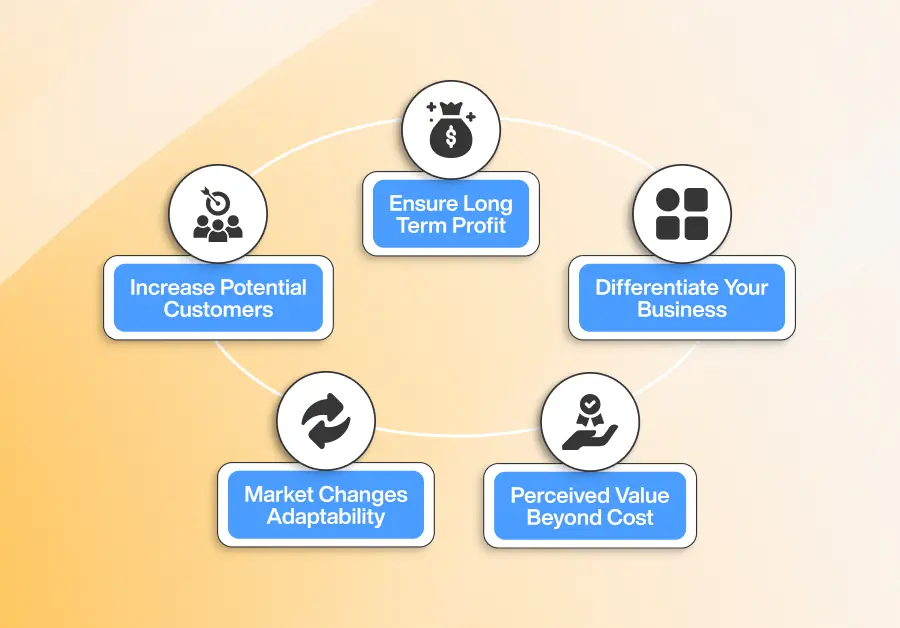
As a Shopify seller or business owner, you should have a custom pricing strategy to shape potential customers’ perception, beat competition, and get long-term profitability. Rather than standard, custom product pricing involves more variables, including personalization, design efforts, uniqueness, and emotional value.
Maybe you’re thinking: “Can’t I just pick a price based on my feeling or use the same price as my competitors?” No, you can’t. Without a well-researched pricing strategy, you’ll probably:
- Set too high a price, which loses potential customers or,
- Set too low, which causes low margins & misses potential profit.
However, there are 5 key benefits of custom product pricing strategies, such as:
1. Ensure long-term profit
A good custom product pricing strategy helps sellers to calculate all costs (i.e., materials, design, platform fees, etc.) and add a profit margin. When you set the product or service price perfectly, you’ll see an uptick in sales. This is where data analysis and market research pay off for your target audience.
2. Increase potential customers
Custom product pricing helps you to communicate your product’s value to consumers by offering multiple price points. When you set up tiered or flexible pricing, you can attract lots of customers without compromising profit margins.
3. Differentiate your business
In a competitive market filled with fixed or standard prices, similar-looking products. Here, custom ones allow your business to differentiate from your competitors, and dynamic pricing becomes a storytelling tool fulfilling consumers’ demand for personalization.
4. Market changes adaptability
A custom product pricing strategy allows you to adjust prices quickly and effectively without disrupting your sales flow. For example, a custom gift store increases personalized mug prices from $20 to $25 during Mother’s Day, when demand spikes.
5. Perceived value beyond cost
Custom products often attach consumers emotionally. When you set a smart pricing strategy lets you price based on perceived value, not just production expense. For example, a hand-engraved wedding gift might cost $15 to produce but sell for $55+ because of its unique, personal, and sentimental value.
Real-Life Case Studies of Custom Product Pricing Strategies
- Amazon: The online retail giant Amazon’s custom pricing strategies are set based on several factors, like competition, demand, and inventory. Rather than offering different prices to different customers, Amazon leverages customer data and analytics that resonate with its customers’ perceived value, comparing its products.
- Beauty industry: Most beauty brand uses a blend of value-based and competitive pricing strategies to set prices by considering customer perceived value and competitors.
Top 11 Pricing Strategies Every Custom Product Store Needs
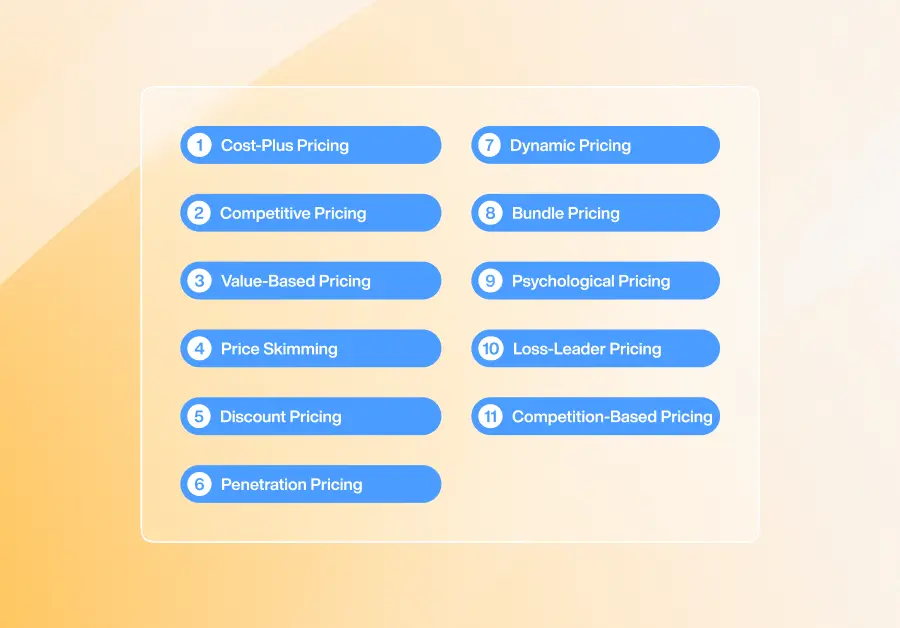
Whether you sell personalized t-shirts, engraved jewelry, custom Halloween gift items, or print-on-demand products, the right pricing strategy helps you to maximize profit, stand out from the competition, and appeal to your ideal customers.
There are different product pricing strategies available, but we’ve discussed the 11 most commonly used custom product pricing strategies:
1. Cost-plus pricing
The cost-plus pricing strategy, also known as “markup pricing” or “breakeven pricing,” in which you calculate all costs (materials, production, packaging, shipping, labor, etc) and add a fixed markup percentage to ensure profit. This pricing method is used in manufacturing and retail industries in which production costs are stable and predictable.
For example, a custom-printed mug costs $8. The charges include (materials, printing, and packaging). When you add a 50% markup, the selling price will be $12 ($8+ 50% of $8).
| Pros | Cons |
| 1. Simple to calculate & implement | 1. May lead to overpricing or underpricing |
| 2. Guarantees a specific profit margin | 2. May lack of market demand & competition |
| 3. Provides pricing stability |
2. Competitive pricing
Competitive pricing is a strategy that helps to set your product price based on what similar competitors charge. It’s simple and low risk, but it might overlook the customers’ perceived value of your products. Sometimes, you may lose profit in a “race to the bottom.” For example, if a personalized wall clock sells between $25-30, you might charge $27 to stay competitive.
| Pros | Cons |
| 1. Simple to implement | 1. Doesn’t consider customers’ perceived value |
| 2. Low risk | 2. May lead to reduced profits |
| 3. Helps maintain market competitiveness |
3. Value-based pricing
Value-based pricing strategy is one of the best pricing strategies for new products, and SaaS product pricing strategies, gift items, luxury, or status goods. This strategy is useful to set a price based on how much customers believe your custom products are worth. Here, emotional connection and personalization play a big role. So, to set this pricing, you require extensive market research and analysis.
| Pros | Cons |
| 1. More profitable compared to cost-plus & competitive | 1. Difficult to set prices |
| 2. Ideal for scaling businesses | 2. If the price is not set perfectly, there is a risk of damaging the reputation |
| 3. Works well for brands with high customer loyalty |
4. Price skimming
Do you sell tech custom products? If yes, the price skimming may be the winning strategy for you. It involves setting a high price and lowering it when more competitors emerge and offer a similar product. However, this pricing strategy might not be successful unless you’re confident your product will be in high demand.
| Pros | Cons |
| 1. Allows for high initial revenue | 1. Might not be suitable for long-term |
| 2. Works well for unique products | 2. Requires confidence in product quality |
| 3. Can capitalize on early adopters |
5. Discount pricing
In 2025, Statista showed that 28% of online shoppers actively seek out coupons before making a purchase. That’s why a discount pricing strategy is popular to increase foot traffic to your store, clear out unsold items, and attract price-conscious customers.
| Pros | Cons |
| 1. Attract potential customers | 1. If not applied professionally can negatively impact your brand value |
| 2. Create positive buzz & increase sales | |
| 3. Excellent way to move out-of-season or older inventory |
6. Penetration pricing
Want to introduce a new product in a crowded market? The penetration pricing strategy is the best fit for your business. The key is to set your product prices low to start and then raise them later based on consumers’ demand. To make it more enticing, you can apply discount codes.
| Pros | Cons |
| 1. Helps to gain market share in a competitive marketplace | 1. May lead to initial losses |
| 2. Can attract new customers | |
| 3. Useful for brand awareness |
7. Dynamic pricing
Dynamic pricing involves applying variable prices instead of fixed ones. Do you ever notice Uber prices spike on a Friday & Saturday night? Uber’s dynamic pricing is set based on a number of variables, such as time and distance of your route, traffic, and demand for riders. These types of product pricing strategies help you achieve business profit margins. But all you need to analyze consumer demand, supply, and competitor pricing.
| Pros | Cons |
| 1. Saves time through automation | 1. Challenging for small businesses due to upfront costs |
| 2. Maximize profits | |
| 3. Improve customer satisfaction |
8. Bundle Pricing
The product bundle pricing marketing strategy is effective when you sell multiple products for a single price. For example, buy one get one (BOGO) discounts. This bundle pricing tactic is a proven method for increasing AOV and revenue per customer.
| Pros | Cons |
| 1. Increase sales volume | 1. If not done properly may reduce profits |
| 2. Encourage repeat purchase/ buy more | |
| 3. Effective for clearing inventory |
9. Psychological pricing
Another effective product pricing strategy is psychological pricing that uses consumers’ insights, which influence buying decisions. Instead of cost-plus or value-based pricing, this method focuses more on emotional responses to make prices more appealing and effective. For example, a classic psychological pricing is $4.99, which appears cheaper at first glance than one priced at $5.
| Pros | Cons |
| 1. Increase conversion rates | 1. May not work for all types of products or markets |
| 2. Leverages consumer psychology | |
| 3. Can trigger impulse buys. |
10. Loss-leader pricing
Loss-leader pricing strategy focuses on selling products at a loss or low price to entice customers to purchase more profitable items from the store or website. Don’t mix up with penetration pricing because loss-leader applies to specific products for short-term promotions. On the contrary, penetration is usually a broader, longer-term strategy applied to a whole product line or brand.
| Pros | Cons |
| 1. Attracts new customers instantly | 1. Initial losses on the discounted products |
| 2. Increase store visibility & sales | |
| 3. Builds brand awareness |
11. Competition-based pricing
The last, yet most effective pricing strategy is competition-based pricing, which helps you offer better prices than your competitors. As a custom product seller, you need to monitor other competitors who sell personalized items and set your prices in line with, above, or a little below, depending on your positioning and value proposition.
| Pros | Cons |
| 1. Saves time on price calculations | 1. May undervalue unique products |
| 2. Quick market positioning | |
| 3. Reduces risk of overpricing |
How to Choose an Effective Pricing Strategy for Custom Product Stores?
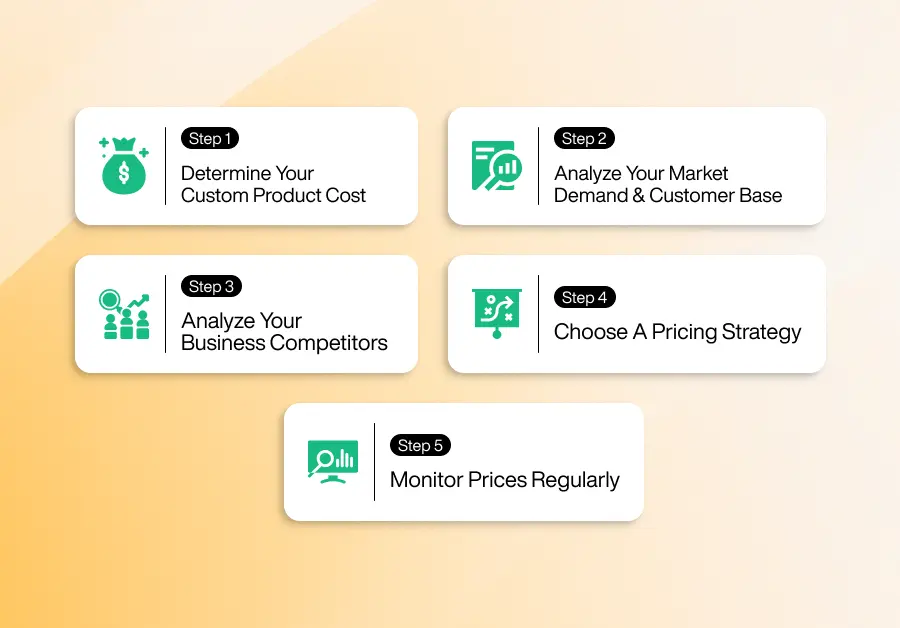
To choose an effective pricing strategy for a custom product store, you must balance product costs, perceived customer value, market demand, and competitive pricing. Picking the right pricing is more than just selecting a number; it’s about aligning price with value, targeting potential consumers, and achieving long-term business goals.
Here’s a step-by-step pricing strategy guide to help you through the price analysis process.
1. Determine your custom product cost
To calculate the real cost of your custom product, first calculate all your expenses, including making and delivering your custom product, including:
- Materials
- Design time
- Production time
- Packaging
- Shipping taxes
- App customizer app or platform fees
| “The formula to calculate the product cost is: Product cost = Direct Material cost + Direct Labour cost + overhead cost” |
2. Analyze your market demand & customer base
Surveys, focus groups, or questionnaires can help determine how your target market responds to your current pricing model. Also, different customers perceive value differently. So, pay attention to your target customers’ value and how much they’re willing to pay for your custom product.
3. Analyze competitors
There are two types of competitors to analyze pricing: direct and indirect. Direct competitors sell the same product that you sell. Whereas, indirect ones sell alternative products that are comparable to what you sell. Research both and also pay attention to custom stores on Shopify, Etsy, and Amazon to understand price ranges. But avoid matching prices without context- your design quality, customization options, packaging, or others may differ.
4. Choose a pricing strategy
Based on your custom product type, business goal, ideal customer type, and market value, choose one from the 11 best pricing strategies we’ve mentioned earlier. For example,
- Cost-plus pricing is best for physical goods or beginners.
- Value-based pricing is best for personalized products.
- Tiered pricing is best for stores with customization options.
- Bundle pricing is best for stores selling event or family sets.
- Dynamic/seasonal pricing is best for holiday or event-based products.
- Competitive pricing is best for crowded markets with many direct competitors, and so on.
5. Monitor prices regularly
After setting the right starting prices for your product, regularly check to ensure the price points convert best and how buyers react to premium options, including:
- Discounts drive sales or not
- Bundle offer vs. single-item purchase
- Previous pricing vs. current pricing
It’s important to stay responsive and adapt to the market changes by observing what customers want, what the competition is doing, and your business sales.
Custom Product Pricing Setup with InkyBay
Now that you’ve selected the right pricing strategy for your custom product store, the next step is to set up and show dynamic and accurate pricing inside your store’s system. But how can you display custom product pricing based on color, sizes, printing types, and so on?
Use a Shopify personalizer app, InkyBay, and showcase different pricing based on customized options. Why InkyBay? Our Shopify app developers tested different product configurator apps and suggest using InkyBay for its tiered pricing options, that is suitable for print-on-demand, personalized, and configurable products. Also, it lets your customers personalize designs in real time, while calculating pricing based on every customization they make.
InkyBay Custom product pricing features are mentioned in a table below:
| Pricing Features | What it does | Why it matters |
| 1. Area-based pricing | Charges based on the design size or print area (width x height) | Ensures fair pricing for designs that use more materials or production effort |
| 2. Option-based pricing | Allows you to assign specific customization pricing, like color, text, font, print method, upload graphics, and product materials | Charge for premium choices, no need to create multiple product variants |
| 3. Quantity-based (tiered) pricing | Automatic volume discounts, i.e., 1-10 units -> $20 each 11-50 units-> $18 each and so on. | Encourage bulk purchases & increase AOV |
| 4. Printing types pricing | Setup fee, per square inch printing, number & name pricing, rules-based (i.e., full-color print), color-based pricing, print locations (i.e., front, back, sides), etc. | Provide you with the flexibility to set dynamic pricing based on printing methods |
1. Product customization pricing
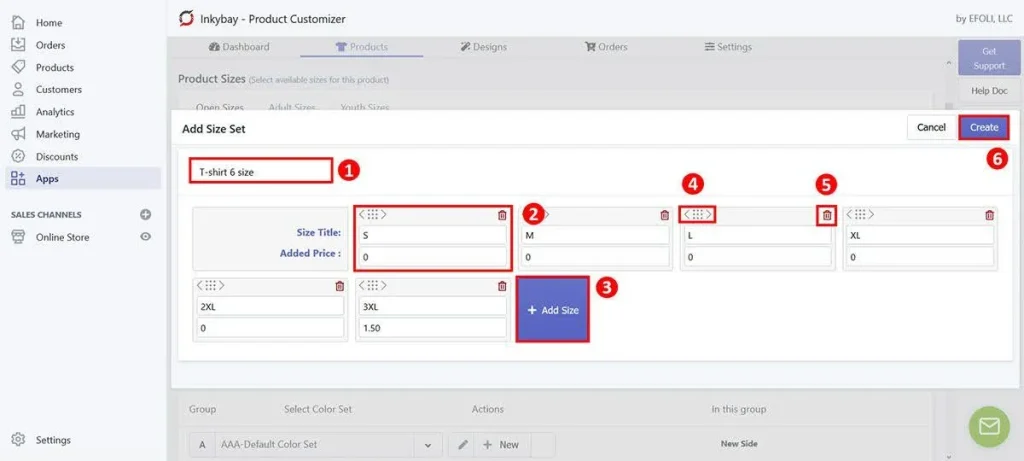
You get the flexibility to add multiple styles and set pricing. For this, click the “Products” option from the top bar and select “Create a Custom Product“. After that, you can set your desired product sizes depending on your product category, as shown below.
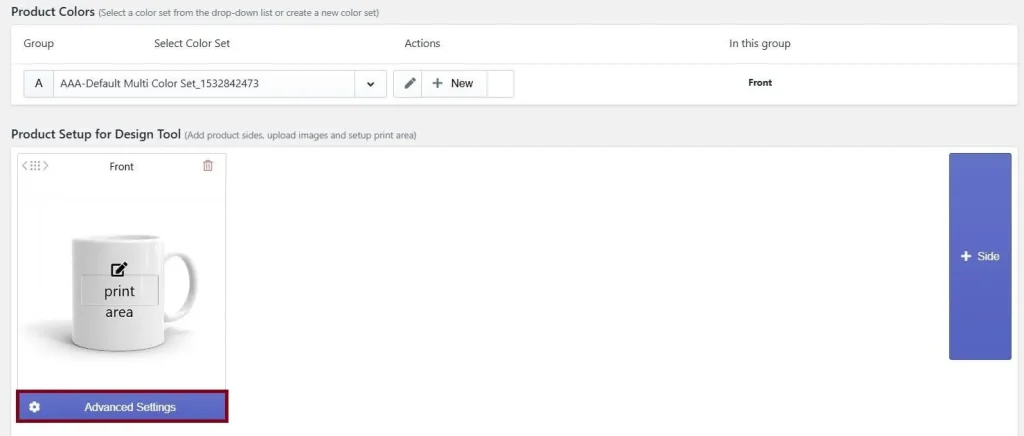
After that, select your required printing types or quantity discount/tiered pricing and set pricing per printing categories, which we’ll discuss in the “Printing types & customization pricing” section.
In the “Product Colors” section, you can select a color set from the listings or create a new product color set. For this, click the “advanced settings” option as shown below.
After that, you can add a new style, color set, and set extra pricing just like the image below. Not only the print color, but you can also set product color pricing with the InkyBay app.
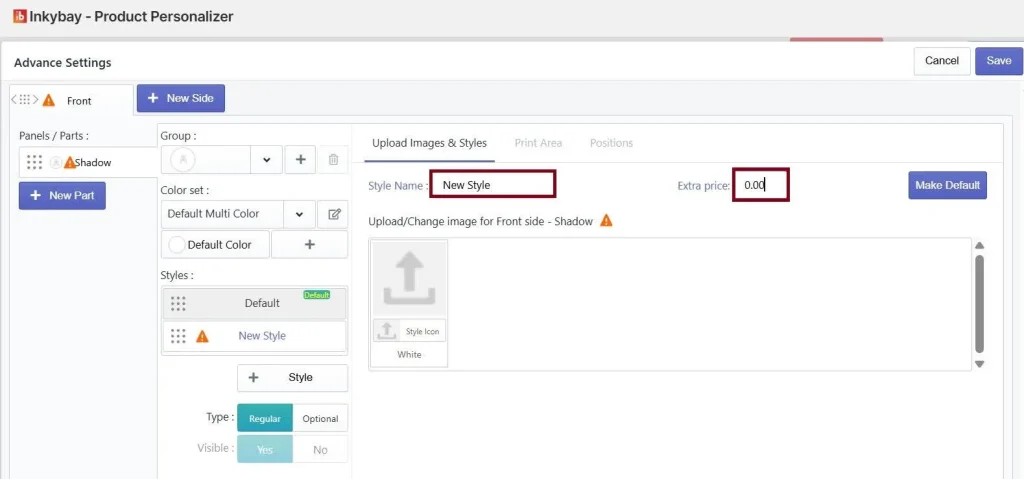
2. Area-based pricing
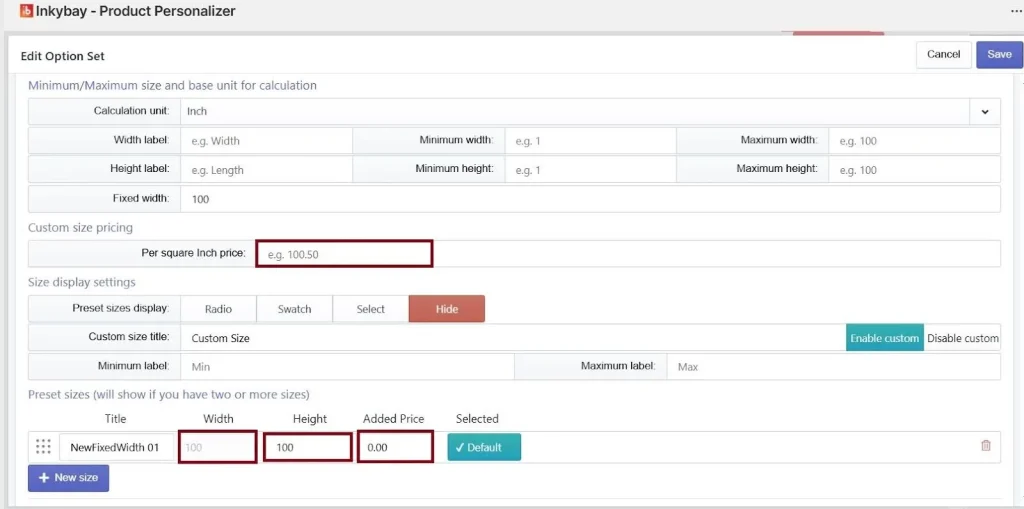
This pricing allows you to charge customers based on the actual size of the printable or design area. You need to define specific price ranges per square inch/cm/ft of print area, and InkyBay calculates the total price based on the design dimensions the customer creates in the live product designer.
3. Option-based pricing
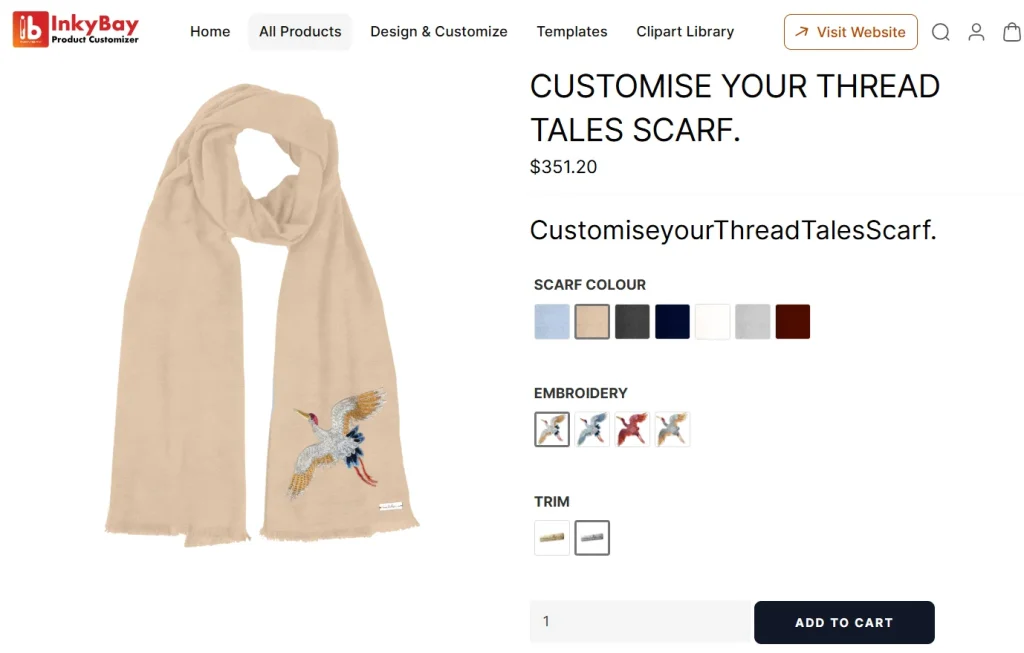
Do you want to set different product variants (i.e., color, graphics, text, cliparts, or others) on your products and show pricing depending on consumers’ selections? If yes, InkyBay’s option-based pricing is best for you. That means this pricing option is suitable for a product personalization feature. But if you wish, you can set conditional logic and different customization pricing per product variant.
For example, you want to sell scarves offering 7 different colors, embroideries, and logo variations as in the image below.
Not only that, you get the flexibility to add an unlimited number of product options set with unlimited combinations, like swatch, checkbox options, file uploads, dropdowns, and others, to provide the options you need to sell your products. For more details, check out the help video for how to configure product options.
4. Quantity-based discount
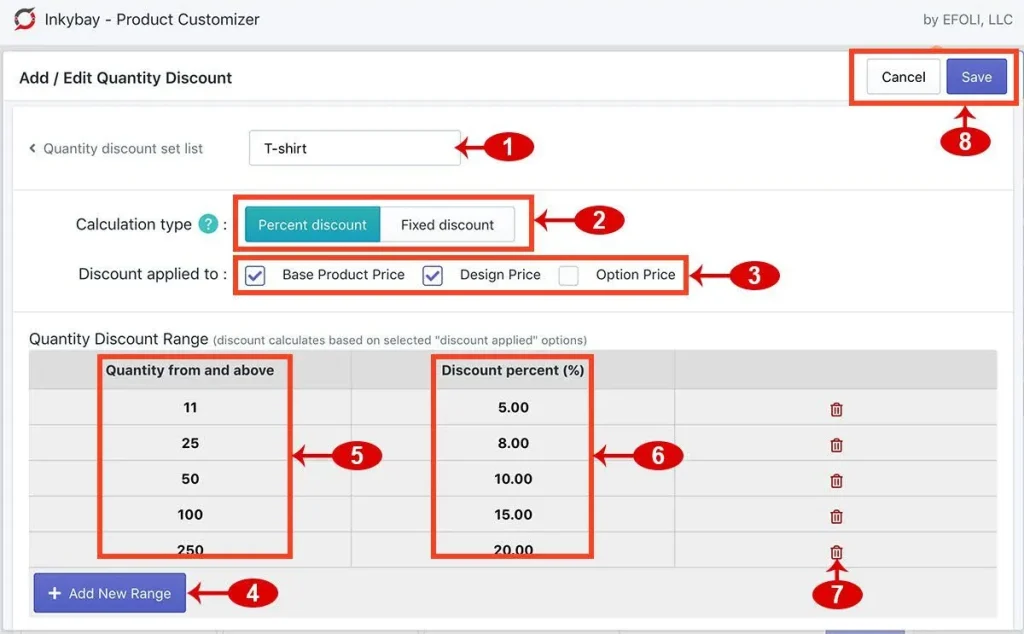
With the InkyBay app, you don’t need to use 3rd party apps to apply quantity discounts for your custom products. Easily create a multiple (no limit) quantity discount set and apply it to your custom products through: base product price, design/customization price, and option price
Click the video link and discover how to create a quantity discount set for your personalized product.
5. Printing types & customization pricing
InkyBay, the product personalizer tool, allows you to assign different price structures depending on the printing method or production process, such as –
- Screen printing
- DTG (direct-to-garment)
- Premium vinyl
- Flex print
- Sublimination
In printing types, there are 4 different options to set prices:
Basic pricing: In this section, you can set up a fee for the entire design, upload colors, an initial price for text, graphics, cliparts, name, number pricing, per square inch price, and others. See the image below for in-depth details.
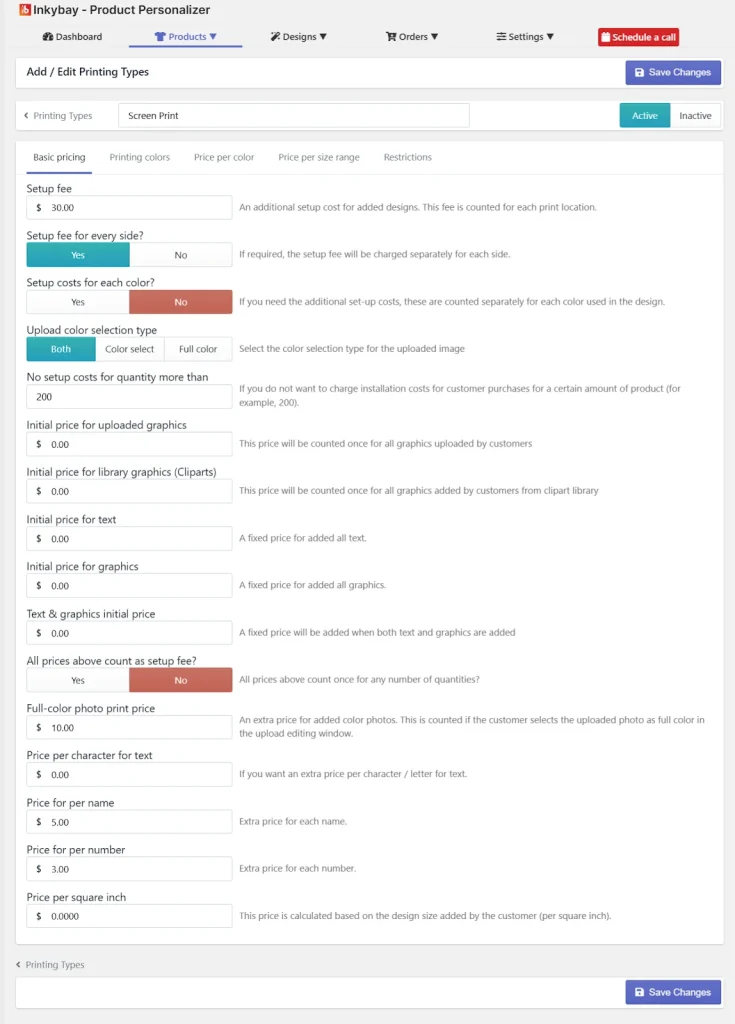
Printing colors: If you have any extra price for printing color, you can add and set a price per color. Also, you’ve the flexibility to re-arrange the colors, click and drag the colors with the dotted icon on the left side.
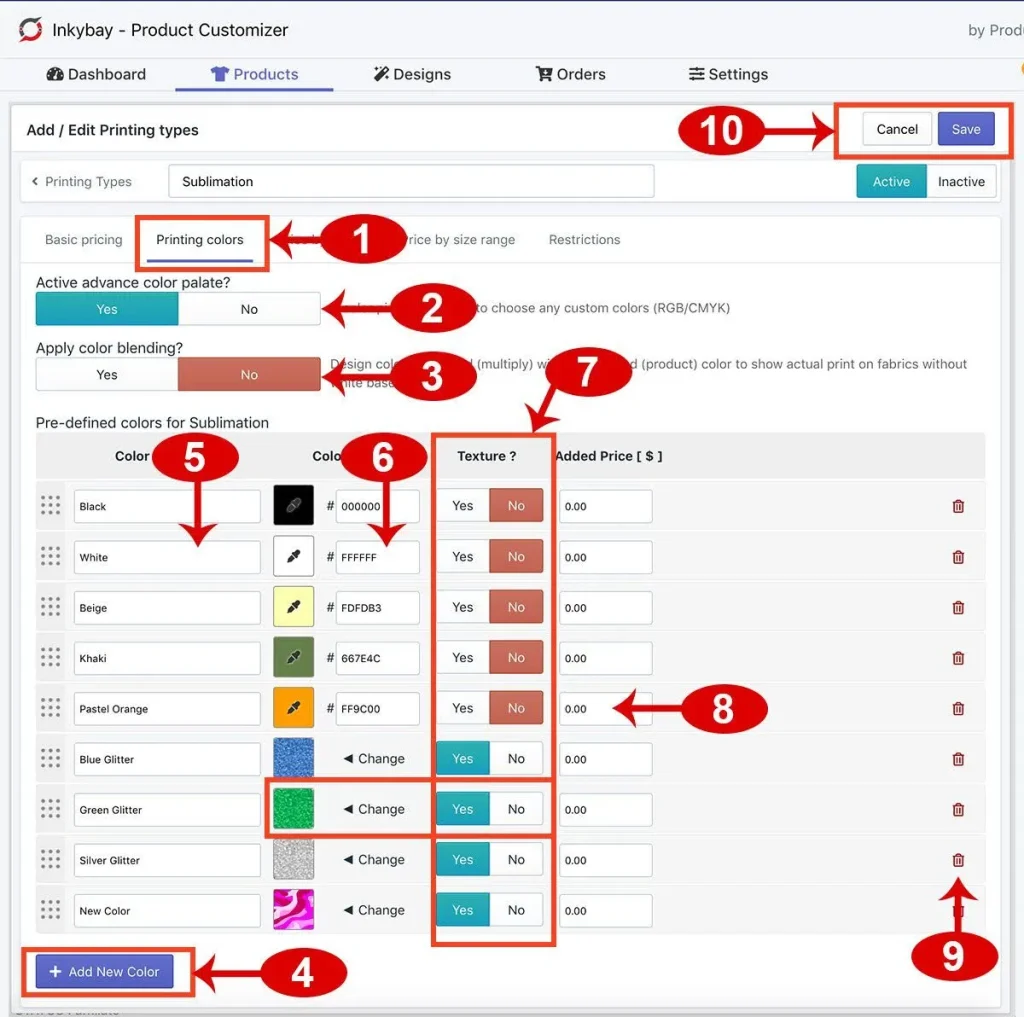
Price by colors: You can combine the pricing based number of print colors and product quantity numbers. Also, you can set discounted customization pricing based on the number of products and the number of colors.
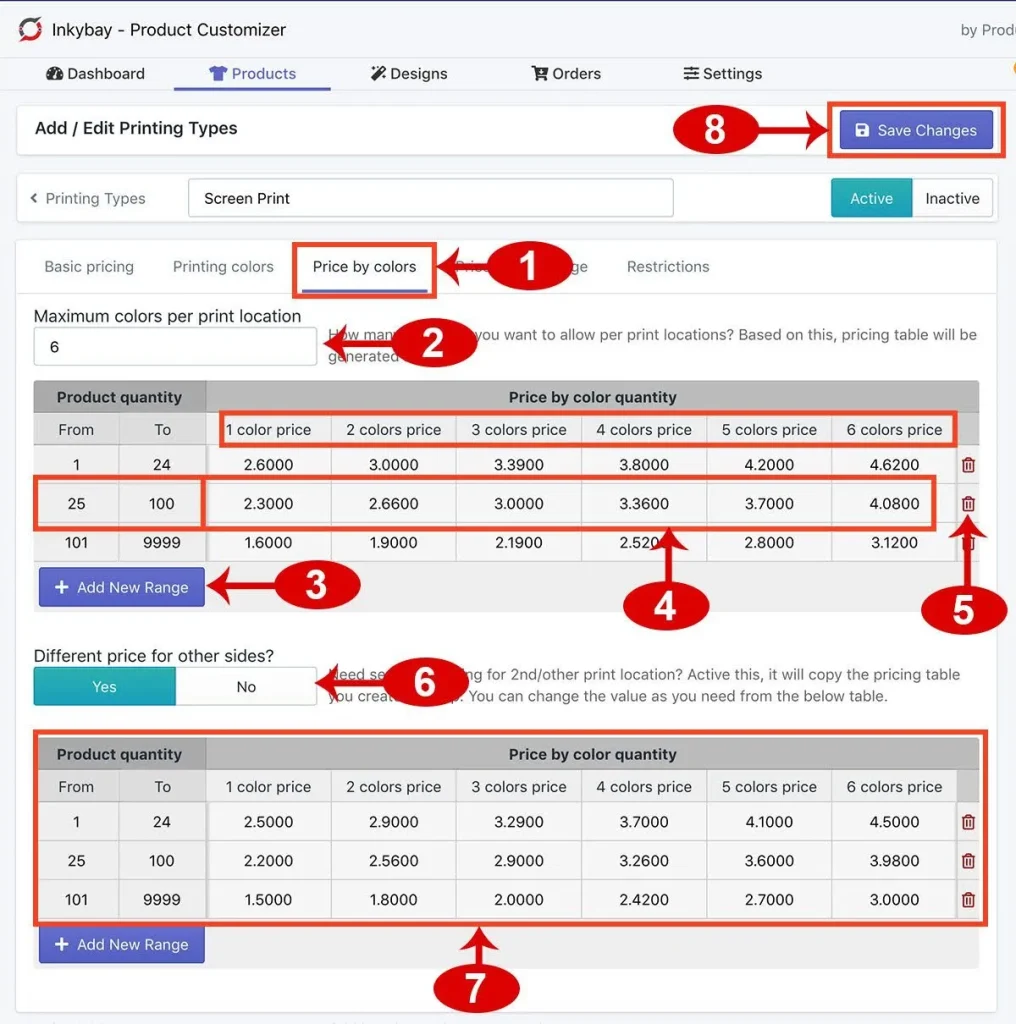
Price by size range: You get flexibility to set up customization pricing based on the customer’s added design total size range, product quantity range, and product color type.
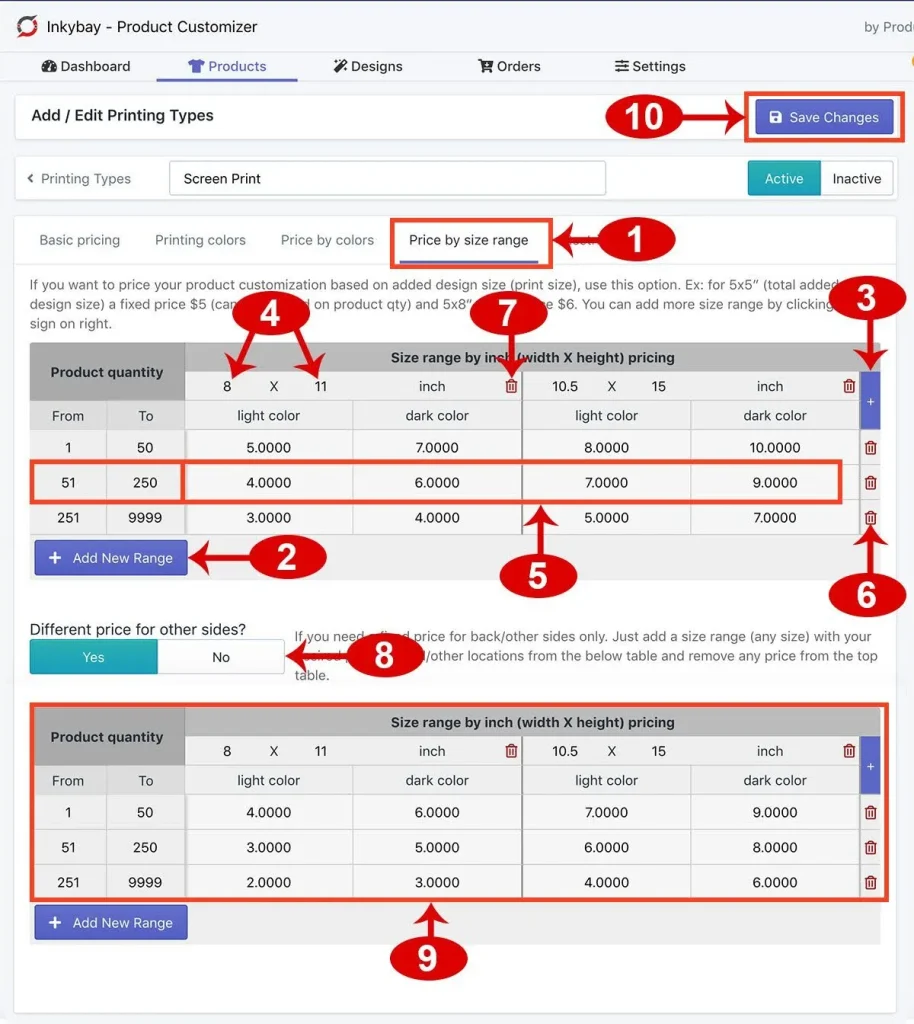
If you want to set your customization product printing types, check out the video link for step-by-step instructions.
Common Mistakes to Avoid in Custom Product Pricing
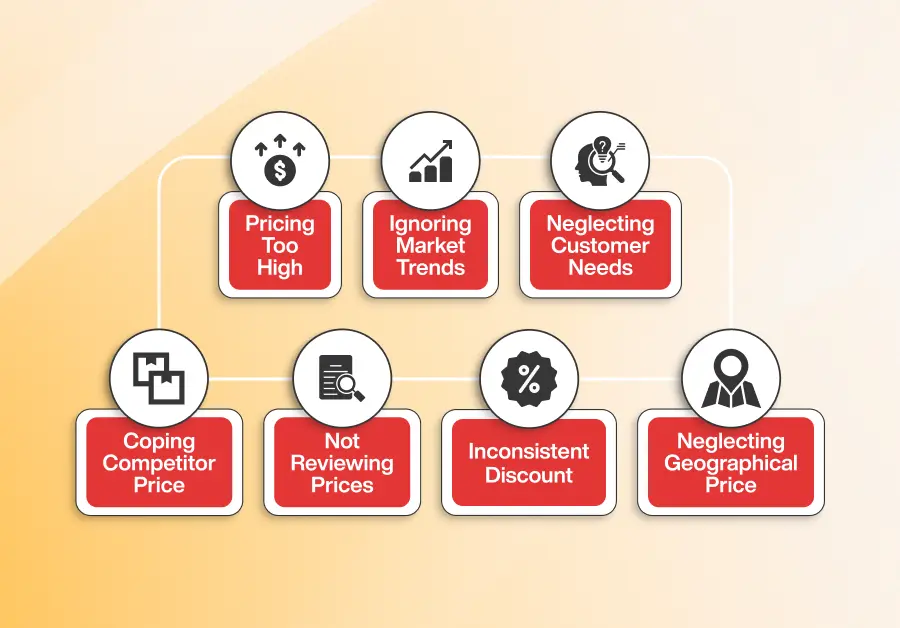
The 7 common custom product pricing mistakes you need to avoid are as follows:
Mistake 1: Pricing too high
If you charge too much for your custom products without clearly mentioning why the product is worth it, you is a chance to lose potential consumers. For example, if you sell a personalized leather keychain for $50 but provide no reason for this price or quality assurance. Then, customers compare it with other competitors who offer similar products at an affordable price and abandon the cart.
Best practice: If charging high, provide consumers a reason behind it, like highlighting premium materials, craftsmanship, design uniqueness, packaging, etc.
Mistake 2: Ignoring market trends
Do you keep prices flat year-round? You then miss millions of dollars during high-demand seasons. Suppose you sell a personalized Halloween bag at $7 and keep the same price during the Halloween season. On the contrary, your competitors may charge a little higher with amazing offers. Keeping prices static over long periods and ignoring market trends may be perceived as a low-quality option.
Best practice: To fix this pricing mistake, take time to calculate product costs and grab the seasonal deal. For this, you can research your competitors’ product pricing and set a price point that works for your margins and also in the market.
Mistake 3: Neglecting customer needs
Another common pricing mistake is to treat all customers the same. If you run a business of different products and services, then there is a chance that you’ve multiple customer profiles in your store. In this case, try to come up with a standard pricing strategy that is equally effective across your product line. Otherwise, you may lose sales and profit.
Best practice: If possible, segment customers and develop unique pricing, or you can set custom pricing depending on personalization options.
Mistake 4: Coping with competitor pricing
Sometimes, blindly coping with competitor pricing might not be considered a pricing mistake. But when you ignore your business goals, customer value, and costs, it leads to lower profit margins. Also, expert marketers suggest focusing more on price can distract potential consumers and destroy trust.
Best practice: Always keep prices aligned with your business goals. Remember, it’s easy to lower prices, but not easy to raise them again.
Mistake 5: Not reviewing or updating prices
Product prices might change over time based on market & competitive dynamics, customer demand, cost, etc. If you don’t review your prices regularly, you might find that you’re pricing too low or too high, which negatively affects your consumers.
Best practice: Regularly review pricing and update if required. Also, test different price points to set the best pricing and see them in action.
Mistake 6: Inconsistent or excessive discount
When you offer inconsistent or excessive discounts, it affects your company’s brand image, profit, and customer relationships. Though discounts are a useful marketing tool to drive sales, misusing them creates long-term issues, weakens customers’ trust, and might attract the wrong consumers.
Best practice: Offer discounts for specific purposes, such as clearing old inventory, introducing new custom products, or time-limited discounts create a sense of urgency.
Mistake 7: Neglecting geographical pricing
When you overlook geographical pricing, it’ll affect your company’s growth, sales, and market position. Internal business requires consideration of local regulations, consumer behaviors, and costs to set prices that ensure your business’s success. Whereas a fixed pricing model fails to account for regional differences in operating costs, like shipping, taxes, etc.
Best practice: If your product has global market demands, you must consider a geographical pricing strategy that helps to differentiate from local markets and attract new consumers.
Frequently Asked Questions About Custom Product Pricing Strategies
What is personalized pricing?
Personalized pricing, also known as dynamic pricing, refers to an e-commerce business strategy that offers different product prices based on customization options. Personalized pricing varies based on various factors, including location, product customization options, and others.
What are the differences between pricing strategies and pricing techniques?
The key differences between pricing strategies and techniques lie in their scope and application. A pricing strategy refers to overall business pricing details to meet objectives, like profit maximization, market penetration, etc. On the other hand, pricing techniques indicates to implementing a specific aspect of the strategy, i.e., a sales promotion.
Why are pricing strategies important to businesses?
Pricing strategies are important for businesses to achieve business objectives, such as –
Maximize profits
Boost sales volume
Increase market share
Attract new customers and
Build brand value.
How do businesses use pricing strategies to attract customers?
Businesses employ pricing strategies to attract customers by aligning pricing with their overall strategy, brand positioning, and market demand, thereby creating value and differentiating themselves from competitors.
What are the three most common pricing strategies?
The three most common pricing strategies are competition-based pricing, cost-plus pricing, and value-based pricing.
Can a business use more than one pricing method?
Yes, a business can use more than one pricing method depending on the product, target audience, competition, and the company’s objectives.
How does product pricing affect marketing strategies?
Product pricing has a direct impact on marketing strategies, such as sales volume, profit margins, and the company’s competitive position in the market.
Final Verdict
There is no one-size-fits-all approach or rules to set pricing for your custom products. Not every pricing strategy works for every custom product store. So, it’s up to you to research and decide what works best for your products, marketing, and target customers.
Share with us your effective pricing strategy and hacks on how you achieve your business goals!


